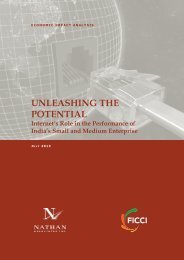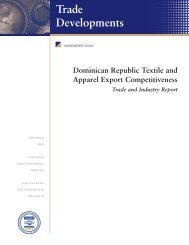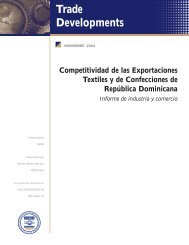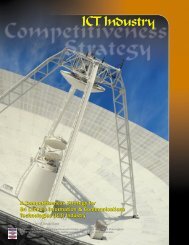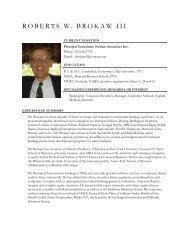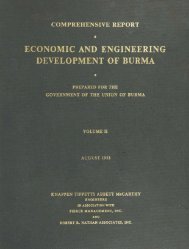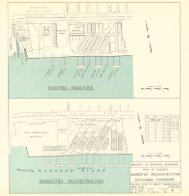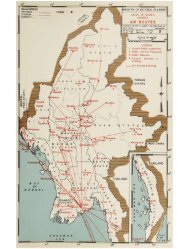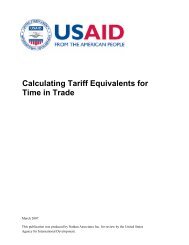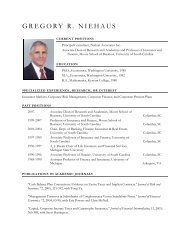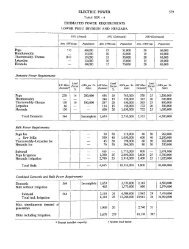Putting it to Work in Developing Countries - Nathan Associates
Putting it to Work in Developing Countries - Nathan Associates
Putting it to Work in Developing Countries - Nathan Associates
Create successful ePaper yourself
Turn your PDF publications into a flip-book with our unique Google optimized e-Paper software.
Outsourc<strong>in</strong>g. The practice of mov<strong>in</strong>g an <strong>in</strong>ternal production<br />
activ<strong>it</strong>y, task, or process <strong>to</strong> a location other<br />
than the home base of an organization, <strong>in</strong> the home<br />
country or overseas. Outsourced activ<strong>it</strong>ies and related<br />
facil<strong>it</strong>ies are not normally part of an enterprise’s core<br />
activ<strong>it</strong>ies (e.g., human resources functions of a car manufacturer).<br />
The enterprise does not “own” the foreign<br />
facil<strong>it</strong>ies do<strong>in</strong>g outsourced work.<br />
Overseas Private Investment Corporation (OPIC).<br />
Organization created by an act of the U.S. Congress<br />
that provides loans, guarantees, and <strong>in</strong>surance for do<strong>in</strong>g<br />
bus<strong>in</strong>ess <strong>in</strong> emerg<strong>in</strong>g markets.<br />
Parent company. A mult<strong>in</strong>ational corporation’s home<br />
country–based firm.<br />
Performance requirements. Government rules stipulat<strong>in</strong>g<br />
that foreign <strong>in</strong>ves<strong>to</strong>rs must meet particular national<br />
objectives, such as a directive that a certa<strong>in</strong> amount of<br />
production be exported, or conta<strong>in</strong> a specified proportion<br />
of local content.<br />
Policy Framework for Investment (PFI). A series of<br />
OECD guidel<strong>in</strong>es for creat<strong>in</strong>g a high-qual<strong>it</strong>y climate<br />
for foreign and domestic <strong>in</strong>ves<strong>to</strong>rs. The guidel<strong>in</strong>es<br />
cover ten policy areas: <strong>in</strong>vestment policy, <strong>in</strong>vestment<br />
promotion and facil<strong>it</strong>ation, trade policy, compet<strong>it</strong>ion<br />
policy, tax policy, corporate governance, policies for<br />
promot<strong>in</strong>g responsible bus<strong>in</strong>ess conduct, human<br />
resource development, <strong>in</strong>frastructure and f<strong>in</strong>ancial sec<strong>to</strong>r<br />
development, and public governance.<br />
Pol<strong>it</strong>ical risk. Possibil<strong>it</strong>y that a pol<strong>it</strong>ical event, such as<br />
war, or noncommercial development, such as economic<br />
nationalism, will result <strong>in</strong> expropriation or will restrict<br />
repatriation of FDI earn<strong>in</strong>gs.<br />
Privatization. Partial or <strong>to</strong>tal sale of state-owned enterprises<br />
and commercial <strong>in</strong>terests <strong>to</strong> private <strong>in</strong>ves<strong>to</strong>rs.<br />
Prof<strong>it</strong> repatriation. Flow of FDI earn<strong>in</strong>gs back <strong>to</strong> the<br />
parent company’s home country.<br />
Production efficiency. Cost sav<strong>in</strong>gs due <strong>to</strong> discovery or<br />
us of new production processes or technologies.<br />
Public <strong>in</strong>vestment. Expend<strong>it</strong>ure by government on<br />
public goods or government-owned companies.<br />
“Race <strong>to</strong> the bot<strong>to</strong>m.” Relaxation of environmental<br />
and labor standards by countries <strong>to</strong> ga<strong>in</strong> a compet<strong>it</strong>ive<br />
edge <strong>in</strong> attract<strong>in</strong>g FDI.<br />
Regula<strong>to</strong>ry framework for <strong>in</strong>vestment. The entire legal<br />
and regula<strong>to</strong>ry system govern<strong>in</strong>g the entry, operation,<br />
and ex<strong>it</strong> strategies of <strong>in</strong>ves<strong>to</strong>rs w<strong>it</strong>h<strong>in</strong> a country or<br />
region. A relatively well-designed, transparent, and stable<br />
regula<strong>to</strong>ry framework is important for all <strong>in</strong>vestment,<br />
particularly foreign <strong>in</strong>vestment.<br />
Re<strong>in</strong>vested earn<strong>in</strong>gs. Portion of prof<strong>it</strong> of foreign subsidiaries<br />
and associated enterprises (the direct <strong>in</strong>vestment<br />
enterprise) not distributed as dividends or rem<strong>it</strong>ted<br />
<strong>to</strong> the <strong>in</strong>ves<strong>to</strong>r’s home country.<br />
Resident <strong>in</strong>vestment adviser. Foreign expert who works<br />
full time <strong>in</strong> a develop<strong>in</strong>g country’s <strong>in</strong>vestment promotion<br />
<strong>in</strong>termediary <strong>to</strong> advise on the country’s <strong>in</strong>vestment promotion<br />
agenda.<br />
“Round tripp<strong>in</strong>g.” Domestic <strong>in</strong>vestment disguised as<br />
foreign <strong>in</strong>vestment <strong>to</strong> qualify for tax and other <strong>in</strong>centives<br />
available only <strong>to</strong> foreign <strong>in</strong>ves<strong>to</strong>rs. Investment<br />
cap<strong>it</strong>al can also flow “out” <strong>to</strong> take advantage of higher<br />
returns overseas and then flow “<strong>in</strong>” as foreign <strong>in</strong>vestment.<br />
Can result <strong>in</strong> double count<strong>in</strong>g of FDI <strong>in</strong>flow.<br />
Often refers <strong>to</strong> Ch<strong>in</strong>ese <strong>in</strong>vestment <strong>in</strong> Hong Kong that<br />
is re<strong>in</strong>vested <strong>in</strong><strong>to</strong> Ch<strong>in</strong>a <strong>to</strong> take advantage of preferential<br />
treatment accorded foreign <strong>in</strong>vestment.<br />
Services sec<strong>to</strong>r. Sec<strong>to</strong>r that produces a broad range of<br />
nontangible products and is <strong>in</strong>creas<strong>in</strong>gly the largest <strong>in</strong><br />
most economies; <strong>in</strong>cludes bank<strong>in</strong>g and f<strong>in</strong>ance, transportation,<br />
retail, <strong>to</strong>urism, travel, construction and<br />
health, among others.<br />
S<strong>in</strong>gapore issues. Four issues on the WTO agenda:<br />
<strong>in</strong>vestment, compet<strong>it</strong>ion policy, trade facil<strong>it</strong>ation, and<br />
transparency <strong>in</strong> government procurement. At the WTO<br />
M<strong>in</strong>isterial meet<strong>in</strong>g <strong>in</strong> S<strong>in</strong>gapore (1996), m<strong>in</strong>isters<br />
agreed <strong>to</strong> create work<strong>in</strong>g groups <strong>to</strong> explore a multilateral<br />
framework for each issue. At the Cancun WTO<br />
M<strong>in</strong>isterial <strong>in</strong> September 2003, countries failed <strong>to</strong><br />
reach consensus on future negotiations on any of these<br />
issues. In the summer of 2004, WTO members agreed<br />
<strong>to</strong> establish a negotiat<strong>in</strong>g group on trade facil<strong>it</strong>ation,<br />
but consensus on the rema<strong>in</strong><strong>in</strong>g three S<strong>in</strong>gapore issues<br />
has rema<strong>in</strong>ed elusive.<br />
South-South FDI. Inward FDI <strong>in</strong><strong>to</strong> a develop<strong>in</strong>g<br />
country from another develop<strong>in</strong>g country. Ch<strong>in</strong>ese and<br />
South African companies are <strong>in</strong>creas<strong>in</strong>gly active<br />
<strong>in</strong>ves<strong>to</strong>rs <strong>in</strong> Asia and Africa, respectively.<br />
Spillover effect. Transfer or absorption of technology,<br />
expertise, or productiv<strong>it</strong>y improvements <strong>to</strong> host-country<br />
firms or sec<strong>to</strong>rs through <strong>in</strong>teraction w<strong>it</strong>h direct<br />
<strong>in</strong>vestment enterprises. See vertical and horizontal<br />
spillovers.<br />
S<strong>to</strong>ck, FDI. Total value of foreign-owned assets <strong>in</strong> a<br />
country at a given po<strong>in</strong>t <strong>in</strong> time. Can be measured <strong>in</strong><br />
terms of <strong>in</strong>ward or outward flows of FDI.<br />
Subsidiary. An <strong>in</strong>corporated enterprise <strong>in</strong> a host country<br />
<strong>in</strong> which another ent<strong>it</strong>y directly owns more than<br />
half of the shareholders’ vot<strong>in</strong>g power, or is a shareholder<br />
<strong>in</strong> the enterprise, and has the right <strong>to</strong> appo<strong>in</strong>t or<br />
remove a major<strong>it</strong>y of the members of the adm<strong>in</strong>istrative,<br />
managerial, or supervisory body.<br />
C-5



